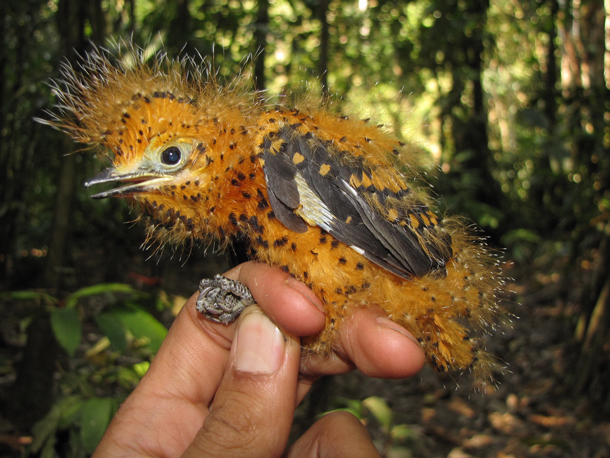BirdNote®: How a Bird Came to Look Like a Caterpillar
Air Date: Week of March 15, 2019

The Cinereous Mourner (Laniocera hypopyrra) is a quintessential example of Batesian mimicry, the disguise that some harmless creatures adopt in order to trick would-be predators into thinking they’re dangerous. (Photo: © David R. Santiago)
The Amazon rainforest is home to a wide array of fantastically-attired species. Among them is a bird whose chick, incredibly, looks like a caterpillar! BirdNote’s Michael Stein explains how evolution has driven a phenomenon called Batesian mimicry, in which certain species try to trick their would-be predators into thinking they’d make for a dangerous meal.
Transcript
[BIRDNOTE THEME]
CURWOOD: The unique evolutionary pressures of life in the Amazon rainforest
have spawned an incredible array of fabulously-attired animals. BirdNote’s Michael Stein tells us about a colorful bird that evolved to mimic… a caterpillar.
BirdNote®
How a Bird Came to Look Like a Caterpillar
STEIN: In nature, one way to avoid being eaten is to look like something you’re not—ideally, something that tastes really awful — or that might even kill you.
Science calls this Batesian mimicry, named for a 19th century naturalist. Bates found that some perfectly edible butterflies had evolved color patterns that mimic those of toxic butterflies, which predators avoid.
Well, these butterflies are not alone.
The Cinereous Mourner is a small, ashy-gray bird that lives in the forest understory of the Amazon Basin. And it’s taking mimicry to the next level: its chick looks like a poisonous caterpillar!
[Cinereous Mourner call, https://macaulaylibrary.org/asset/98606, 0.10-.14]
The chick is covered in vivid orange feathers punctuated with black dots. Lying alone in its cup-shaped nest, it’s a near match to a highly toxic caterpillar — one that snakes and monkeys won’t eat. The chick even waves its head like a caterpillar, increasing the illusion.
Cinereous Mourners live in an area where many birds’ nestlings are routinely lost to predators—and this may explain how a bird wound up dressed as a deadly caterpillar.
[Cinereous Mourner call, https://macaulaylibrary.org/asset/98606, 0.10-.14]
I’m Michael Stein.
###
Written by Bob Sundstrom
Bird sounds provided by The Macaulay Library of Natural Sounds at the Cornell Lab of Ornithology, Ithaca, New York. Recorded by ML 225024 B. Oshea and ML 98606 D Finch.
BirdNote’s theme music composed and played by Nancy Rumbel and John Kessler.
Producer: John Kessler; Managing Producer: Jason Saul; Editor: Ashley Ahearn; Associate Producer: Ellen Blackstone; Assistant Producer: Mark Bramhill.
© 2019 Tune In to Nature.org March 2019 Narrator: Michael Stein
https://www.birdnote.org/show/how-bird-came-look-caterpillar
CURWOOD: For pictures, fly on over to our website, loe.org.
Links
This story on the BirdNote® website
More about the Cinereous Mourner from the Cornell Lab of Ornithology
Living on Earth wants to hear from you!
Living on Earth
62 Calef Highway, Suite 212
Lee, NH 03861
Telephone: 617-287-4121
E-mail: comments@loe.org
Newsletter [Click here]
Donate to Living on Earth!
Living on Earth is an independent media program and relies entirely on contributions from listeners and institutions supporting public service. Please donate now to preserve an independent environmental voice.
NewsletterLiving on Earth offers a weekly delivery of the show's rundown to your mailbox. Sign up for our newsletter today!
 Sailors For The Sea: Be the change you want to sea.
Sailors For The Sea: Be the change you want to sea.
 The Grantham Foundation for the Protection of the Environment: Committed to protecting and improving the health of the global environment.
The Grantham Foundation for the Protection of the Environment: Committed to protecting and improving the health of the global environment.
 Contribute to Living on Earth and receive, as our gift to you, an archival print of one of Mark Seth Lender's extraordinary wildlife photographs. Follow the link to see Mark's current collection of photographs.
Contribute to Living on Earth and receive, as our gift to you, an archival print of one of Mark Seth Lender's extraordinary wildlife photographs. Follow the link to see Mark's current collection of photographs.
 Buy a signed copy of Mark Seth Lender's book Smeagull the Seagull & support Living on Earth
Buy a signed copy of Mark Seth Lender's book Smeagull the Seagull & support Living on Earth

